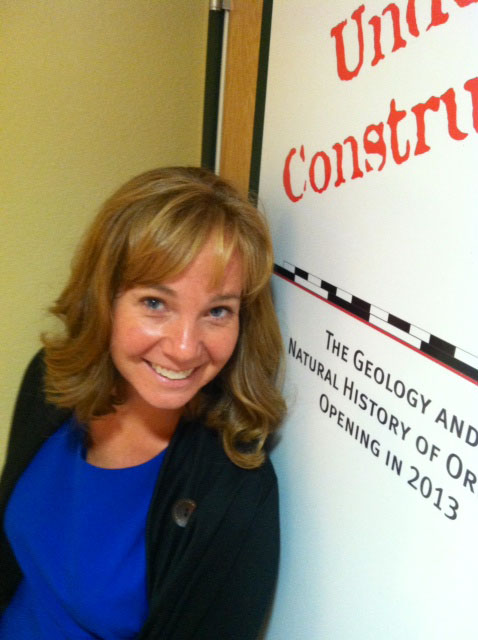I am managing the design and construction of a new exhibition wing at the University of Oregon (UO) Museum of Natural and Cultural History in Eugene, Oregon. The project has been in the works since 2009. It’s my first big project as a museum professional and I’ve learned a great deal. This post is a brief look the process so far and an attempt to get help from those of you with vastly more experience. The exhibit opens in May 2013.
1. It took time and patience, but we assembled the right team.
We have a great team that includes scientists who specialize in the exhibit content, which is geology, paleontology, and other natural history; exhibit designers, both new and experienced, including in-house staff and contracted specialists; artists; a specialist in museum evaluation; and an educator and project manager – that’s me. To get the broadest perspective, we were mindful to include a healthy balance of institutional memory and fresh new ideas as well as museum “insiders” and outside contractors. Most importantly, everyone is genuinely interested in the subject and passionate about sharing it with others.
2. We didn’t define decision-makers and advisors among our team. Next time I will do this when participants initially join the team.
While the team appreciates each other’s areas of specialty, our problems center on our roles: Who is a decision maker and who is an advisor? Coming from Eugene, Oregon we are used to striving for consensus and focusing on process – it’s in the water here. While I admire this in theory, it hasn’t worked in practice. There are power differentials around the table that affect our discussions. As project manager it’s my job to monitor these intangibles and make sure the right people are heard. Because some team members assume responsibility beyond their position, I have had to decline work and then spend time and attention rebuilding trust and nursing hurt feelings to keep everyone involved.
How should we ensure continued participation with stakeholders who are feeling dismissed?
- We keep the project as transparent as possible.
We use project management software called Base Camp https://basecamp.com/, which I highly recommend for many organizational reasons, but mostly because it enables transparency. All of our email communication, documents, meeting notes, and edits to text or images are available for everyone on the team to see. I believe it gives people the same kind of sense as being on camera – you’re on your best behavior because everyone is watching. From an organizational perspective, it’s much easier to keep track of everything and since it’s web based I don’t have to worry about someone’s hard drive crashing and losing work. As with any tool, it only works if you use it.
- We get mired in details and lose momentum. It’s frustrating, but maybe it’s a necessary part of the process.
In 2009, Dr. Alice Parman, an adjunct faculty member and consultant on this project created a solid interpretive plan after many interviews, focus groups, and facilitated conversations with a broad cross-section of our stakeholders. It is supposed to serve as our guiding light. However, since then the team has narrowed to a small working group and we devote too much time to small sections instead of the broader goals. We can ruminate over which evolutionary branches of canids should be included in a graphic for days. As important as these details are, the discussions deplete our momentum.
How can we stay focused on the broad goals when we are responsible for the details as well?
- Test! Test! Test!
Prototyping components for the exhibit hall has been one of the best parts of the project. We were honored to receive an Institute of Museum and Library Services (IMLS) grant to make this possible; the cost would likely have been prohibitive otherwise. Once a section is on exhibit, our evaluation consultant and UO faculty member Dr. Phaedra Livingstone, supervisors a team of graduate students and volunteers who observe how people move through the space, conduct interviews with willing visitors, and facilitate focus groups. By doing this, the components are vetted for mechanical durability, clarity, interest, and connection to our core messages. We have never before prototyped or evaluated this way; it’s a sort of “coming of age” for our institution and I believe it will compel us to be more accountable to our many types of visitors.
As I look beyond the opening of this exhibit hall, currently slated for my birthday (a gift to myself!), I think about everything I would do differently next time. I’m young enough in my career that I may very well rebuild this exhibit hall someday. I hope it will be a little easier the second time around!
I have poured over the preliminary WMA conference program in anticipation of the sessions that will help me evaluate and make meaningful adjustments for this and future projects. I am looking most forward to Post-Mortem: Let’s Make Our Next Exhibition Project More Successful. Considering how much the new exhibition wing is going to affect our day-to-day work and our long-term planning, I am also planning to attend Strategic Planning as a Tool for Museum Development. In preparation for my next big project, a permanent exhibition on the research conducted by our archaeologists, The Joy of Discovery: Sharing Research with the Public, is also on the top of my list. I expect these sessions will inspire and rejuvenate me, reinforce the “right” things I have done, and help me avoid and correct challenges ahead.
Ann Craig is a 2012 Wanda Chin Scholarship recipient. She is the Associate Director for Public Programs at the University of Oregon Museum of Natural and Cultural History.









Add new comment